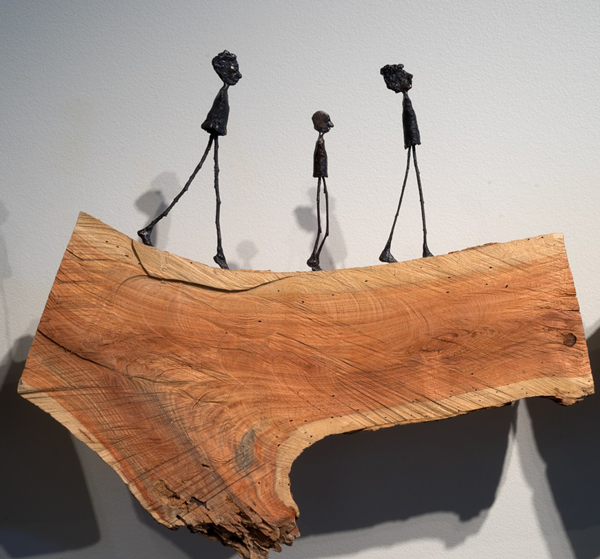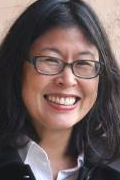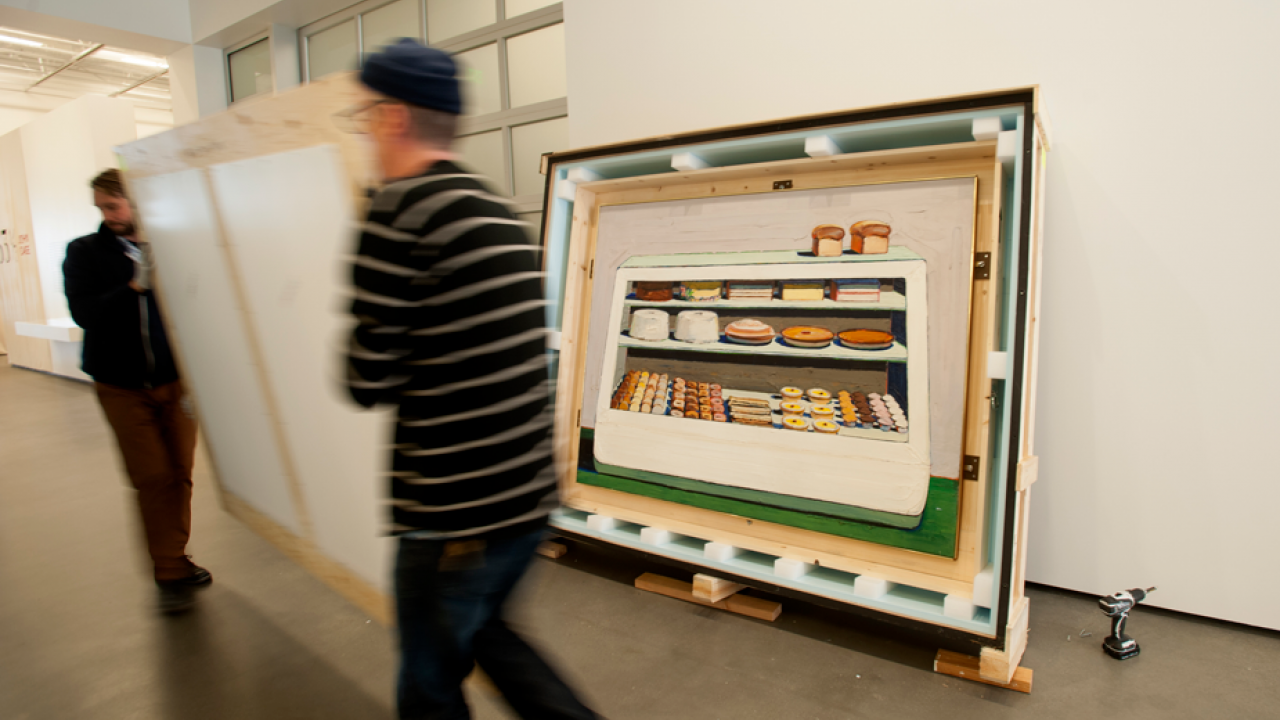The new year brings all-new exhibitions at the university’s three art museums:
- The Design Museum goes first with It’s Bugged: Insects’ Role in Design, opening Jan. 8. (Reception Jan. 11, featuring a talk by Ann Savageau, professor emerita of design.)
- The C.N. Gorman Museum is next with storytelling in multimedia by by Holly Wilson (Delaware Nation/Cherokee), opening Jan. 9. (Artist talk and closing reception March 14.)
- The Jan Shrem and Maria Manetti Shrem Museum of Art opens Jan. 16 with a major showing of early works by painter and professor emeritus Wayne Thiebaud; and an alternative view of still-life art, by way of a silent film by Tacita Dean. (Public opening celebration Jan. 18.)
The 1-year-old Manetti Shrem Museum also presents its first faculty-curated show, ¿¡Welcome?! — by Susette Min, associate professor, Department of Asian American Studies — opening Feb. 1. (Faculty tour Jan. 30, opening reception Feb. 1.)
Admission is free to all three museums (and opening and closing events); public welcome.
Design Museum

It’s Bugged: Insects’ Role in Design — Exploring the “complex and compelling” relationship between people and insects. On one side, we have makers, designers, architects and artists who draw upon nature’s patterns to create beautiful and useful materials and structures. On the other side, we have insects as producers of raw materials, and the insects’ human collaborators who harvest silk, for example, or make red dye from cochineals. While the insects are (likely!) not conscious of this duality, the outcomes are useful for insects and for people in different ways. This exhibition features objects from UC Davis’ JoAnn C. Stabb Design Collection, along with works by Professor Emerita Savageau and Master of Fine Arts students Alicia Decker, Lauren Kelly and Cory Wolffs. And, in keeping with the Design Museum’s year of design/science, the exhibition also includes insect specimens on loan from the UC Davis Bohart Museum of Entomology. Jan. 8-April 22, Design Museum, 124 Cruess Hall. Regular hours: noon-4 p.m. weekdays and 2-4 p.m. Sunday. Opening reception: 6-8 p.m. Thursday (Jan. 11), featuring Professor Emerita Savageau’s talk at 6:30 p.m.
Some of these relationships are centuries old, while other ways people are using insects and insect behavior is relatively new. What’s exciting to me is to think about all the new products, designs and technologies that are still to come as people continue to be inspired by insects. — Adrienne McGraw, guest curator
C.N. Gorman Museum


Holly Wilson: Talk Story — “Narrative is central to my work,” Wilson says in her artist’s statement. “I am interested in stories — the stories of my parents, my ancestors, my family, my community. I am a storyteller; through my work, I weave together the threads of these various narratives to create a tapestry that tells stories that are sacred and precious, personal and universal, powerful and at times volatile.” Wilson effectively employs various sophisticated and at times subtle strategies in addressing serious and challenging themes — displacement, cancer/illness, boarding schools, social decay, genocide and cultural survival. Additionally, she manipulates and juxtaposes scale to engage her audience while initially obscuring the more profound meaning in the pieces. Their diminutive size forces the viewer to move closer to capture the detail, to see the piece completely. Their gestures and poses, which, on the surface, may at times appear whimsical, belie their often darker and deeper meanings. These figures are often juxtaposed with larger pieces of wood, creating a visual tension. Jan. 9-March 16, C.N. Gorman Museum, 1316 Hart Hall. Regular hours: noon-5 p.m. weekdays and 2-5 p.m. Sunday. Artist talk and closing reception: 4-6 p.m. Wednesday, March 14.
‘Telling (these stories) brings to life things sometimes kept secret, hidden, and not permitted to be said because they challenge the status quo or reveal realities that neither side wants said.’ — Holly Wilson
Manetti Shrem Museum
The Jan Shrem and Maria Manetti Shrem Museum of Art presents three exhibitions in winter and spring, with one of them extending a few days into summer.
RELATED PROGRAMS
Wayne Thiebaud: 1958-1968
- “The Here and There of Painting — Space and Light as Material,” 4:30 p.m. Thursday, Feb. 8.
- “Understanding Thiebaud — Views of the Painter and His Work,” 2 p.m. Saturday, Feb. 10.
- “The Delirious Sorrow of Cheerful Things: The Art of Wayne Thiebaud,” 5:30 p.m. Thursday, March 1.
- “How I Learned to Paint,” 5 p.m. Thursday, April 5.
¿¡Welcome?!
- “Border Protests and Transnational Solidarities,” 4-6 p.m. Wednesday, Feb. 14.
- “Cross-Border Citizens,” 4-5:30 p.m. Wednesday, April 2.
Wayne Thiebaud: 1958-1968 — Rarely exhibited works from this formative decade of the artist’s career, along with new, related scholarship. Thiebaud, of course, is our very own UC Davis professor emeritus, having joined the art faculty in 1960 — and one of Northern California’s best known and most accomplished artists. The timeframe of this exhibition coincides with his transition from the impressionistic style of his early period toward the representational works for which he became widely known: paintings of everyday objects of American life — from gumball machines to swimsuits and slices of pie — rendered with exaggerated colors reminiscent of commercial advertising. In 1962, thanks to a grant from UC Davis, he traveled to New York City for a debut exhibition, at the Allan Stone Gallery — a wildly successful show that launched his national reputation. Jan. 16-May 13. Faculty preview: 4-6 p.m. Thursday, Jan. 11. Public opening celebration: 5-7:30 p.m. Thursday, Jan. 18.
Tacita Dean: Day for Night — This 16mm silent film comprises 20 photographs mirroring still-life works by Giorgio Morandi, the Italian modernist painter and printmaker whom Thiebaud has described as “an artist’s artist.” By looking at these objects in different light, the British artist Dean offers a new read of Morandi’s work. Jan. 16-May 13.

¿¡Welcome?! — The 1-year-old museum’s first faculty-curated exhibition — by Susette Min, associate professor, Department of Asian American Studies — explores the competing meanings of hospitality and the different ways it can be seen as a form of welcome or hostility, driven by necessity and greed, fear and desires, and subject to conventional demands of etiquette and the law. Featured artists include Andrea Bowers, Daniel Martinez, Dan Perjovschi, Kameelah Jana Rasheed and Jin-me Yoon. Co-sponsored by the Mellon Initiative in Comparative Border Studies at UC Davis and the Manetti Shrem Museum. Feb. 1-June 24. Faculty tour with the curator: 4-5:30 p.m. Wednesday, Jan. 30 (RSVP by Jan. 26 to Jennifer Wagelie, academic liaison, by phone, 530-304-4928, or email). Opening reception: 6-8 p.m. Thursday, Feb. 1 (remarks at 7 p.m.).
Manetti Shrem Museum regular hours: noon-6 p.m. Tuesday, Wednesday and Friday; noon-9 p.m. Thursday; and 11 a.m.-5 p.m. Saturday-Sunday. See the museum’s Exhibits and Programs brochure (PDF).
Media Resources
Dateline Staff, 530-752-6556, dateline@ucdavis.edu
